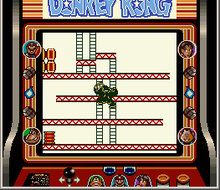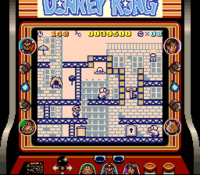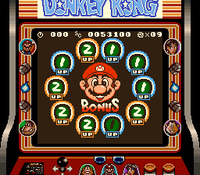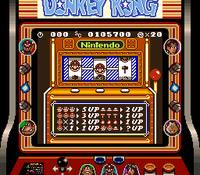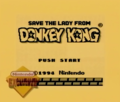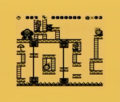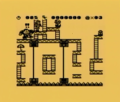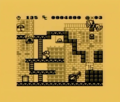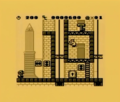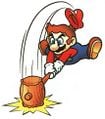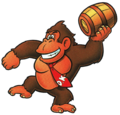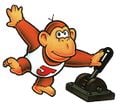Donkey Kong (Game Boy): Difference between revisions
LinkTheLefty (talk | contribs) (I don't know why it seems every source since shortens it since you'd think it'd be less confusing, but - per the game's own logo - the Japanese print manuals overtly identify the game as「ゲームボーイ ドンキーコング」(Game Boy Donkey Kong).) |
|||
| (193 intermediate revisions by 74 users not shown) | |||
| Line 1: | Line 1: | ||
{{italic title | {{italic title}} | ||
{{FA}} | {{FA}} | ||
{{ | {{game infobox | ||
|image=[[File:DKGBBoxAmerica.jpg|250px]] | |||
|image=[[File: | |||
|developer=[[Nintendo EAD]], [[Pax Softnica]] | |developer=[[Nintendo EAD]], [[Pax Softnica]] | ||
|publisher=[[Nintendo]] | |publisher=[[Nintendo]] | ||
| | |release='''Game Boy:'''<br>{{release|Japan|June 14, 1994|USA|June 1994<ref>''Super Smash Bros. Brawl'' [[smashwiki:Chronicle|Chronicle]]</ref>|Europe|September 24, 1994}} '''Virtual Console (3DS):'''<br>{{release|Japan|June 15, 2011|Europe|June 16, 2011|USA|June 16, 2011|Australia|June 16, 2011|South Korea|February 3, 2016}} | ||
|genre=2D Platform, Puzzle | |genre=2D [[Genre#Platform|Platform]], [[Genre#Puzzle|Puzzle]] | ||
|modes=Single-player | |modes=Single-player | ||
|ratings={{ratings|esrb=K-A|pegi=3|acb=G|cero=A}} | |ratings={{ratings|esrb=K-A|pegi=3|acb=G|cero=A}} | ||
|platforms=[[Game Boy]] [[Virtual Console]] ([[Nintendo 3DS]]) | |platforms=[[Game Boy]], [[Virtual Console]] ([[Nintendo 3DS]]) | ||
|media={{media|gb=1|3dsdl=1}} | |media={{media|gb=1|3dsdl=1}} | ||
|input={{input|gb=1|3ds=1}} | |input={{input|gb=1|3ds=1}} | ||
}} | }} | ||
'''''Donkey Kong''''' (alternatively '''''Game Boy Donkey Kong''''', and '''''Donkey Kong '94''''' in early development) is a [[Game Boy]] game released in 1994. The game | '''''Donkey Kong''''' (alternatively '''''Game Boy Donkey Kong''''', and '''''Donkey Kong '94''''' in early development) is a [[Game Boy]] game released in 1994 by [[Nintendo]]. The game starts out with the premise of the original 1981 [[Donkey Kong (game)|''Donkey Kong'' arcade game]]. However, this game qualifies as both an extension and a standalone title; it features 97 additional stages beyond this original premise. It acts as a predecessor to ''[[Mario vs. Donkey Kong]]''. | ||
''Donkey Kong'' is the first game in the [[Super Mario (franchise)|''Super Mario'' franchise]] with specialized support for colored graphics on the [[Super Game Boy]] peripheral for the [[Super Nintendo Entertainment System]]. Its Super Game Boy border resembles the arcade cabinet of the original ''Donkey Kong'' arcade game. The game has slight audio enhancements on the Super Game Boy: [[Pauline]]'s distress cry sounds closer to a realistic cry for help (the Super NES's sound chip supports the inclusion of voice samples), and the credits theme was also enhanced. | |||
''Donkey Kong'' is one of the earlier re-releases on the [[Nintendo 3DS]]'s [[Virtual Console#Nintendo 3DS|Virtual Console]], where it was released internationally in June 2011. It was released in South Korea on February 3, 2016.<ref>[https://www.nintendo.co.kr/3DS/eshop/eshop_virtualconsole.php South Korean Nintendo 3DS Virtual Console page]</ref> | |||
==Story== | ==Story== | ||
[[File:DKClimb.png|thumb|left| | [[File:DKClimb.png|thumb|left|upright=1.1|Donkey Kong carrying Pauline to the top of a construction site.]] | ||
The player takes the role of [[Mario]]. | The player takes the role of [[Mario]]. [[Donkey Kong]] kidnaps Mario's lady friend [[Pauline]] and carries her off to a construction site. In a repeat of [[Donkey Kong (game)|the 1981 arcade classic]], Mario follows him up to the highest point and makes Donkey Kong fall off the platforms by pulling out the rivets supporting them, causing Donkey Kong to fall a height of [[100m]], reuniting Mario and Pauline, just like the events that took place 13 years ago. However, Donkey Kong unexpectedly recovers, takes Pauline, and escapes with her into the [[Big-City]]. Mario pursues the two. | ||
What follows is a chase throughout many different locations. Mario fights and defeats Donkey Kong at the end of each world, but Donkey Kong always stands up again and takes Pauline to the next location. Donkey Kong is aided by many of his friends as well as his son [[Donkey Kong Jr.]], who try to hinder Mario's progress. In the end, Donkey Kong escapes to the [[Tower (world)|Tower]] beyond [[Rocky-Valley]], where he and Mario have a confrontation on the top. After his defeat, Donkey Kong falls off the | What follows is a chase throughout many different locations. Mario fights and defeats Donkey Kong at the end of each world, but Donkey Kong always stands up again and takes Pauline to the next location. Donkey Kong is aided by many of his friends as well as his son [[Donkey Kong Jr.]], who try to hinder Mario's progress. In the end, Donkey Kong escapes to the [[Tower (world)|Tower]] beyond [[Rocky-Valley]], where he and Mario have a confrontation on the top. After his defeat, Donkey Kong falls off the Tower, but he then takes many [[Super Mushroom]]s to augment his size to giant proportions. Mario faces the [[Giant Donkey Kong]] in an epic final battle. After Donkey Kong's final defeat, he falls from the Tower once again as Mario and Pauline are reunited once again. The ending scene shows Mario and Pauline in the [[Mushroom Kingdom]] as Pauline gives him a Super Mushroom to turn Mario into [[Super Mario (form)|Super Mario]]. As Mario becomes super, Donkey Kong (now being back to normal) falls down on top of him. But because Mario now has super strength, he is able to lift up Donkey Kong. Having believed to be captured by both Mario and Pauline, Donkey Kong is left calling for help the same way Pauline did throughout the game. Donkey Kong Jr. jumps into the shot as a photo is taken and the credits roll. The ending photo of the game during the credits shows Mario, Pauline, Donkey Kong, and Donkey Kong Jr. posing in front of Rocky-Valley for a holiday photo, indicating that they have all made amends with each other. | ||
{{br}} | {{br}} | ||
==Stages== | ==Stages== | ||
{| | {|class=wikitable | ||
!Image | !Image | ||
!Information | !Information | ||
| Line 31: | Line 32: | ||
|- | |- | ||
|[[File:DonkeyKong-Stage0(ConstructionSite).png|129px]] | |[[File:DonkeyKong-Stage0(ConstructionSite).png|129px]] | ||
|'''Construction Site''' - The construction site is the setting of the original ''Donkey Kong'' arcade game. In this world, Mario's goal is to get to Donkey Kong, who is standing on the top of the stages [[25m]], [[50m]], and [[75m]]. Blocking Mario's path are enemies such as [[ | |'''[[Construction Site]]''' - The construction site is the setting of the original ''Donkey Kong'' arcade game. In this world, Mario's goal is to get to Donkey Kong, who is standing on the top of the stages [[25m]], [[50m]], and [[75m]]. Blocking Mario's path are enemies such as [[Fireball (Donkey Kong)|Fireball]]s, and platforms with gaps to jump across, [[elevator]]s and [[Conveyor Belt]]s. Donkey Kong also throws [[jack]]s at Mario. In the final stage of the world, [[100m]], Mario has to pull out all the rivets of Donkey Kong's construction to defeat him. | ||
|4 | |4 | ||
|- | |- | ||
|[[File:DonkeyKong-Stage1(BigCity).png]] | |[[File:DonkeyKong-Stage1(BigCity).png]] | ||
|'''[[Big-City]]''' - Big-City is the first world of the game in which Mario has to unlock doors with [[key]]s. It is a basic world that serves as an introduction to the basic items and moves of the game, such as handstands, | |'''[[Big-City]]''' - Big-City is the first world of the game in which Mario has to unlock doors with [[key]]s. It is a basic world that serves as an introduction to the basic items and moves of the game, such as handstands, roads, and ladders. It also contains two boss fights with Donkey Kong. | ||
|8 | |8 | ||
|- | |- | ||
|[[File:DonkeyKong-Stage2(Forest).png]] | |[[File:DonkeyKong-Stage2(Forest).png]] | ||
|'''[[Forest (Donkey Kong)|Forest]]''' - The Forest adds more gameplay elements to the game, such as | |'''[[Forest (Donkey Kong)|Forest]]''' - The Forest adds more gameplay elements to the game, such as [[rope|vertical rope]]s to climb and water to swim in. [[Switch (Donkey Kong)|Switch]]es also make their first appearance - they can make roads appear and disappear. [[Snapjaw]]s that climb on ropes can be taken out with fruit. These stages reference [[Donkey Kong Jr. (game)|''Donkey Kong Jr.'']] | ||
|12 | |12 | ||
|- | |- | ||
|[[File:DonkeyKong-Stage3(Ship).png]] | |[[File:DonkeyKong-Stage3(Ship).png]] | ||
|'''[[Ship]]''' - The stages on the Ship expand on the previously introduced game objects and add new puzzles to them. Mario now has to use | |'''[[Ship]]''' - The stages on the Ship expand on the previously introduced game objects and add new puzzles to them. Mario now has to use Handstand Double Jumps, Wire Spins, and [[Walking Block]]s (to get over spiked gaps) to progress. | ||
|8 | |8 | ||
|- | |- | ||
|[[File:DonkeyKong-Stage4(Jungle).png]] | |[[File:DonkeyKong-Stage4(Jungle).png]] | ||
|'''[[Jungle (Donkey Kong)|Jungle]]''' - The Jungle expands on all types of levels found in the Forest. The complexity of ropes increases, and there are ally creatures like | |'''[[Jungle (Donkey Kong)|Jungle]]''' - The Jungle expands on all types of levels found in the Forest. The complexity of vertical ropes increases, and there are ally creatures like [[Monchee]]s and [[Jumper]]s that help Mario to reach more areas. Enemies such as [[Dorakyū]] hinder Mario's progress while climbing ropes. | ||
|12 | |12 | ||
|- | |- | ||
|[[File:DonkeyKong-Stage5(Desert).png]] | |[[File:DonkeyKong-Stage5(Desert).png]] | ||
|'''[[Desert]]''' - The Desert is the first world to feature [[Super Hammer]]s. They are used to break through walls. Most desert levels have more complex puzzle elements than previous stages. In one stage, Mario has to take the Key up several stories to the | |'''[[Desert]]''' - The Desert is the first world to feature [[Super Hammer]]s. They are used to break through walls. Most desert levels have more complex puzzle elements than the previous stages. In one stage, Mario has to take the Key up several stories to the door by only using ladders, roads and Jump Stands. | ||
|12 | |12 | ||
|- | |- | ||
| Line 67: | Line 68: | ||
|- | |- | ||
|[[File:DonkeyKong-Stage9(Tower).png]] | |[[File:DonkeyKong-Stage9(Tower).png]] | ||
|'''[[Tower (world)|Tower]]''' - The Tower is the final stage of the game. In it, every single level is a boss fight with Donkey Kong or Donkey Kong Jr. Mario has to avoid many obstacles such as [[Poison Mushroom]]s and entire stages consisting of [[ | |'''[[Tower (world)|Tower]]''' - The Tower is the final stage of the game. In it, every single level is a boss fight with Donkey Kong or Donkey Kong Jr. Mario has to avoid many obstacles such as [[Poison Mushroom]]s and entire stages consisting of [[sand block]]s. After Donkey Kong is defeated in stage 9-8, Mario has to fight him again in his giant form in stage 9-9. | ||
|9 | |9 | ||
|} | |} | ||
| Line 74: | Line 75: | ||
===Level progression=== | ===Level progression=== | ||
[[File:Donkey Kong Super Game Boy Screen 9.png|thumb|Stage 1-1.]] | [[File:Donkey Kong Super Game Boy Screen 9.png|thumb|Stage 1-1.]] | ||
The game starts out with four simple levels that Mario must scale in order to reach Pauline. These four levels are | The game starts out with four simple levels that Mario must scale in order to reach Pauline. These four levels are simplified versions of the original ''Donkey Kong'' arcade game. After reaching the top of the structure, Donkey Kong flees with Pauline into the city and beyond. The rest of the game's stages are divided between regular puzzle levels as well as more showdowns with Donkey Kong. | ||
Each world has a varying amount of puzzle levels in which Mario needs to work against time to bring a key to a door to unlock it, thus advancing to the next level. The puzzles consist of building platforms and ladders and using them before they disappear, flipping switches, jumping on moving platforms, avoiding enemies and utilizing conveyor belts. Sometimes, [[Donkey Kong Jr.]] | Each world has a varying amount of puzzle levels in which Mario needs to work against time to bring a key to a door to unlock it, thus advancing to the next level. The puzzles consist of building platforms and ladders and using them before they disappear, flipping switches, jumping on moving platforms, avoiding enemies and utilizing conveyor belts. Sometimes, [[Donkey Kong Jr.]] gets in Mario's way by flipping switches or throwing [[Poison Mushroom|poisonous mushrooms]] at him to shrink him. All puzzles require the player to carefully time jumps and pay attention to the physics of the game - ''Donkey Kong'' thus is a cross between a platformer and a puzzle game. | ||
As well as the puzzle levels, each world has at least two battles with Donkey Kong; one takes place part-way through the stage, and involves Mario reaching Pauline while avoiding the debris falling on him as Donkey Kong [[Ground Pound|causes an impact]]. The second takes place at the end of each stage, and involves avoiding the barrels or other objects that Donkey Kong throws at Mario, picking them up and throwing them back at him. After beating a Donkey Kong boss level, there is a short cutscene of Mario chasing Donkey Kong while showing off how to do a special move in the game to the player. The player also gets one extra life for every 100 seconds of time left | As well as the puzzle levels, each world has at least two battles with Donkey Kong; one takes place part-way through the stage, and involves Mario reaching Pauline while avoiding the debris falling on him as Donkey Kong [[Ground Pound|causes an impact]]. The second takes place at the end of each stage, and involves avoiding the barrels or other objects that Donkey Kong throws at Mario, picking them up and throwing them back at him. After beating a Donkey Kong boss level, there is a short cutscene of Mario chasing Donkey Kong while showing off how to do a special move in the game to the player. The player also gets one extra life for every 100 seconds of time left they had for the previous four levels, rounded up. | ||
Each stage has a time limit in which it has to be beaten. It also keeps track of the high scores for each level. Whether the player made a new record is indicated on the Stage Clear screen after a Donkey Kong boss fight. The current high scores can also be viewed by pressing Start or Select. | Each stage has a time limit in which it has to be beaten. It also keeps track of the high scores for each level. Whether the player made a new record is indicated on the Stage Clear screen after a Donkey Kong boss fight. The current high scores can also be viewed by pressing Start or Select. | ||
| Line 84: | Line 85: | ||
In the final 'Tower' stage, each level consists of chasing Donkey Kong and Donkey Kong Jr. to the top of the tower, avoiding their attacks, eventually trapping Junior in a cage, and defeating a giant Donkey Kong in the final battle. | In the final 'Tower' stage, each level consists of chasing Donkey Kong and Donkey Kong Jr. to the top of the tower, avoiding their attacks, eventually trapping Junior in a cage, and defeating a giant Donkey Kong in the final battle. | ||
===Mini- | ===Mini-games=== | ||
[[File:DKGB MG WheelOfFortune.png|thumb|left|The Wheel of Fortune mini-game.]] | [[File:DKGB MG WheelOfFortune.png|thumb|left|The Wheel of Fortune mini-game.]] | ||
[[File:DKGB MG SlotMachine.png|thumb|The Slot Machine mini-game.]] | [[File:DKGB MG SlotMachine.png|thumb|The Slot Machine mini-game.]] | ||
There are also three items left behind by Pauline in each puzzle level - a parasol, a hat and a bag. Picking all three up before finishing the level | There are also three items left behind by Pauline in each puzzle level - a parasol, a hat and a bag. Picking all three up before finishing the level unlocks a bonus mini-game in which the player can pick up extra lives. In The Wheel of Fortune mini-game, all the player has to do is to press {{button|gb|A}} to stop the wheel to gain either 1, 2 or, in later worlds, 3 lives. It is not possible to lose in The Wheel of Fortune. | ||
In the Slot-Machine mini-game, the player has to press {{button|gb|A}} three times to stop each reel of the slot machine. The icons appearing on the reels are Mario, Donkey Kong, Pauline's hat, a hammer, and a | In the Slot-Machine mini-game, the player has to press {{button|gb|A}} three times to stop each reel of the slot machine. The icons appearing on the reels are Mario, Donkey Kong, Pauline's hat, a hammer, and a Fireball. Mario gains lives for getting one of the following combinations: | ||
{{br}} | {{br}} | ||
{| | {|class=wikitable | ||
|- | |- | ||
|Three Donkey Kongs | |Three Donkey Kongs | ||
| Line 111: | Line 112: | ||
|1 Life | |1 Life | ||
|- | |- | ||
|Three | |Three Fireballs | ||
|1 Life | |1 Life | ||
|- | |- | ||
| Line 117: | Line 118: | ||
|Random | |Random | ||
|} | |} | ||
===Basic controls=== | ===Basic controls=== | ||
Mario is controlled with the {{button|gb|pad}}. The physics in ''Donkey Kong'' are vastly different to those found in the ''[[Super Mario | Mario is controlled with the {{button|gb|pad}}. The physics in ''Donkey Kong'' are vastly different to those found in the ''[[Super Mario (series)|Super Mario]]'' series. The player can jump with the {{button|gb|A}}. Mario's jump allows him to jump on enemies, but it does not go up considerably high. When falling farther than his jump height, Mario does a somersault which gives him a little bit of momentum. If he lands on a small platform, it can cause him to roll over the side and fall off. If he falls further, he gets stunned and is unable to move for several seconds upon hitting the ground, temporarily making him vulnerable. If he falls even farther, he lands on his head and dies upon impact with the ground. | ||
Mario only has one hit point. While he is carrying any item, object or enemy, however, he cannot die. If he gets hit, he | Mario only has one hit point. While he is carrying any item, object or enemy, however, he cannot die. If he gets hit, he instead drops the item and becomes invulnerable for a short amount of time. This can save Mario for most kinds of impending deaths - he even survives [[Spike (obstacle)|spike]]s with it. If he falls too far, however, he drops the item in mid-air. | ||
===Mario's abilities=== | ===Mario's abilities=== | ||
{| | {|class=wikitable | ||
!Picture | !Picture | ||
!Move | !Move | ||
| Line 135: | Line 134: | ||
|[[Crouch]]ing | |[[Crouch]]ing | ||
|Holding Down on the {{button|gb|Pad}}. | |Holding Down on the {{button|gb|Pad}}. | ||
|In the crouching position, Mario can avoid enemy projectiles more easily. He can also get through smaller passages while crouching and being on a conveyor belt. | |In the crouching position, Mario can avoid enemy projectiles more easily. He can also get through smaller passages while crouching and being on a conveyor belt or if Mario is pushed along by some enemies. | ||
|- | |- | ||
|align=center|[[File:Mario Handstand.jpg|100px]] | |align=center|[[File:Mario Handstand.jpg|100px]] | ||
| Line 142: | Line 141: | ||
|The handstand is an essential move in the game. While doing a handstand, Mario is protected from most items that drop onto him from above. Handstands also serve as a preparation for several other moves that Mario can only execute from the handstand position. While doing a handstand, Mario can still move to the right and to the left, but it is considerably slower than walking. | |The handstand is an essential move in the game. While doing a handstand, Mario is protected from most items that drop onto him from above. Handstands also serve as a preparation for several other moves that Mario can only execute from the handstand position. While doing a handstand, Mario can still move to the right and to the left, but it is considerably slower than walking. | ||
|- | |- | ||
|align=center|[[File:Mario High Jump From a Handstand. | |align=center|[[File:Mario High Jump From a Handstand.jpg|100px]] | ||
|[[ | |[[Handstand|Handstand Jump]] | ||
|Pressing {{button|gb|A}} while doing a handstand, then pressing A again on the feet | |Pressing {{button|gb|A}} while doing a handstand, then pressing A again on the feet | ||
| | |Handstand Jumps allow Mario to reach platforms above him. If the Handstand Jump is timed right after Mario goes into the handstand position, a Handstand Double Jump is performed which allows Mario to reach even higher. | ||
|- | |- | ||
|align=center|[[File:Mario Back Flip.jpg|100px]] | |align=center|[[File:Mario Back Flip.jpg|100px]] | ||
|[[ | |[[Backflip]] | ||
|Pressing {{button|gb|A}} while moving and pressing the {{button|gb|Pad}} into the opposite direction | |Pressing {{button|gb|A}} while moving and pressing the {{button|gb|Pad}} into the opposite direction | ||
| | |Backflips allow Mario to quickly reach higher platforms. They reach higher than Handstand Jumps, but come at the disadvantage of having to be in movement to execute them, so they cannot be done on small platforms easily. | ||
|- | |- | ||
|align=center|[[File:Mario Spin.jpg|100px]] | |align=center|[[File:Mario Spin.jpg|100px]] | ||
|[[Spin]] | |[[Wire Spin]] | ||
|Pressing up on the {{button|gb|Pad}} while on a rope | |Pressing up on the {{button|gb|Pad}} while on a rope | ||
|Mario can hang onto | |Mario can hang onto horizontal [[wire|rope]]s if he jumps at them. While hanging on the rope, he can perform a Wire Spin. A subsequent Wire Jump makes it possible for him to reach areas that are very high or very far away. The direction that Mario jumps to after the spin depends on the orientation of the rope. Sometimes, it is just upwards, sometimes it is sideways as well. | ||
|- | |- | ||
|align=center|[[File:Mario Holding a Barrel.jpg|50px]] | |align=center|[[File:Mario Holding a Barrel.jpg|50px]] | ||
| Line 165: | Line 164: | ||
|Throwing objects | |Throwing objects | ||
|Pressing {{button|gb|B}} while holding the object | |Pressing {{button|gb|B}} while holding the object | ||
|Thrown objects can hit enemies and take them out. Some enemies are invulnerable to thrown objects. Mario also has to throw items like the Key upwards if he has to climb a ladder, as he cannot climb while holding any item. The key | |Thrown objects can hit enemies and take them out. Some enemies are invulnerable to thrown objects. Mario also has to throw items like the Key upwards (by pressing up on {{button|gb|pad}} and then {{button|gb|b}}) if he has to climb a ladder, as he cannot climb while holding any item. The key disappears after a few seconds if left alone, while thrown enemies struggle and stand up again. | ||
|} | |} | ||
==Enemies== | ==Enemies== | ||
''Donkey Kong'' features the enemies from the original arcade game ''Donkey Kong'' and many individual enemies of its own that are only found in this game. It does not feature any enemies from the mainstream ''Mario'' games, except for Spark who appears in ''[[Super Mario Bros 2]]''. Many enemies in the game have a different appearance, but the exact same behavior. The appearance usually depends on the current world. | ''Donkey Kong'' features the enemies from the original arcade game ''Donkey Kong'' and many individual enemies of its own that are only found in this game. It does not feature any enemies from the mainstream ''Super Mario'' games, except for [[Spark]], who appears in ''[[Super Mario Bros. 2]]''. Many enemies in the game have a different appearance, but the exact same behavior. The appearance usually depends on the current world. | ||
{|width=100% | {|class=wikitable width=100% | ||
|- | |- | ||
! Enemy | !Enemy | ||
! Name | !Name | ||
! Debut | !Debut | ||
! Abilities | !Abilities | ||
|- | |- | ||
|align=center|[[File: | |align=center|[[File:DKGB Fire.png]] | ||
|align=center|[[ | |align=center|[[Fireball (Donkey Kong)|Fireball]] | ||
| | |[[Construction Site]], [[25m]] | ||
| | |Fireballs chase Mario and can appear out of [[oil drum]]s that catch fire. If Mario touches one, he burns up. It can be defeated with the [[hammer]]. | ||
|- | |- | ||
|align=center|[[File: | |align=center|[[File:DKGB Foxfire.png]] | ||
|align=center|[[Fire (100m)|Fire]] | |||
|Construction Site, [[100m]] | |||
|Fireballs that are slightly larger than usual and spawn from the sides of the screen. If Mario touches one, he burns up. It can be defeated with the hammer. | |||
|- | |||
|align=center|[[File:DKGB Oil.png]] | |||
|align=center|[[Oil]] | |align=center|[[Oil]] | ||
|[[Big-City]], | |[[Big-City]], [[Stage 1-1]] | ||
|Oil only consists of an aura of fire with the text "oil" written on it. It floats up and down in place without trying to attack Mario, but touching it is deadly. It can be defeated with the hammer. | |Oil only consists of an aura of fire with the text "oil" written on it. It floats up and down in place without trying to attack Mario, but touching it is deadly. It can be defeated with the hammer. | ||
|- | |- | ||
|align=center|[[File: | |align=center|[[File:DKGB Rappy.png]] | ||
|align=center|[[Bowbow]] | |align=center|[[Bowbow]] | ||
| | |Big-City, Stage 1-1 | ||
|Bowbows just lumber horizontally from one side of a platform to another. Mario | |Bowbows just lumber horizontally from one side of a platform to another. Mario dies if he gets in contact with a Bowbow from the front or back, but he can easily hop on its head, pick it up and hurl it away. If Mario approaches Bowbows with the hammer, they start to run away in panic. | ||
|- | |- | ||
|align=center|[[File: | |align=center|[[File:DKGB Bowbow.png]] | ||
|align=center|[[Rappy]] | |align=center|[[Rappy]] | ||
| | |Big-City, [[Stage 1-2]] | ||
|rowspan=4|These enemies circle completely around midair platforms, including walking on their bottom side. In other stages, they also walk around the entire border of the level, even over spikes. They cannot hurt Mario, but they can push him off the platform if he is in their way. They can also be stood on, but not picked up. | |rowspan=4|These enemies circle completely around midair platforms, including walking on their bottom side. In other stages, they also walk around the entire border of the level, even over spikes. They cannot hurt Mario, but they can push him off the platform if he is in their way. They can also be stood on, but not picked up. | ||
|- | |- | ||
|align=center|[[File: | |align=center|[[File:DKGB Dotty.png]] | ||
|align=center|[[Dotty]] | |align=center|[[Dotty]] | ||
|[[Forest (Donkey Kong)|Forest]], | |[[Forest (Donkey Kong)|Forest]], [[Stage 2-1]] | ||
|- | |- | ||
|align=center|[[File: | |align=center|[[File:DKGB Armadillo.png]] | ||
|align=center|[[Arumajiron]] | |align=center|[[Arumajiron]] | ||
|[[Desert]], | |[[Desert]], [[Stage 5-7]] | ||
|- | |- | ||
|align=center|[[File: | |align=center|[[File:DKGB Seal.png]] | ||
|align=center|[[Purupuru]] | |align=center|[[Purupuru]] | ||
|[[Iceberg]], | |[[Iceberg]], [[Stage 7-3]] | ||
|- | |- | ||
|align=center|[[File: | |align=center|[[File:DKGB Spark.png]] | ||
|align=center|[[ | |align=center|[[Wire Trap]] | ||
| | |Big-City, [[Stage 1-3]] | ||
|Sparks move along [[rope]]s and electrocute Mario if he touches them. They may also appear and disappear from the rope in certain time intervals. | |Sparks which move along horizontal [[wire|rope]]s and electrocute Mario if he touches them. They may also appear and disappear from the rope in certain time intervals. They can also not be harmed in any way. | ||
|- | |- | ||
|align=center|[[File: | |align=center|[[File:DKGB TrashCan.png]] | ||
|align=center|[[ | |align=center|[[Bucket Man|Dust Man]] | ||
| | |Big-City, Stage 1-3 | ||
| | |Dust Men look like ordinary [[Bin|Trash Cans]] at first glance, but grow feet and eyes once Mario gets too close. They then wander around aimlessly and can defeat Mario if they knock into him. Mario can safely stand on top of them, but they cannot be lifted like normal Trash Cans. | ||
|- | |- | ||
|align=center|[[File: | |align=center|[[File:DKGB WalkingFlame.png]] | ||
|align=center|[[Faiachū]] | |align=center|[[Faiachū]] | ||
| | |Big-City, [[Stage 1-5]] | ||
| | |Fireballs with feet that circle around the area, and they also walk up walls and on ceilings. They burn Mario if he comes into contact with them. Faiachū also cannot be taken out by Trash Cans. In the Iceberg world, Faiachū melt [[Ice Block]]s as soon as they walk over them, clearing the path for Mario to reach other areas of the level. | ||
|- | |- | ||
|align=center|[[File: | |align=center|[[File:DKGB Spider.png]] | ||
|align=center|[[Sniper]] | |align=center|[[Sniper]] | ||
| | |Forest, Stage 2-1 | ||
|rowspan=4|These enemies circle completely around midair platforms, including walk on their bottom side. In other stages, they also walk around the entire border of the level, even over spikes. They kill Mario if he touches them. | |rowspan=4|These enemies circle completely around midair platforms, including walk on their bottom side. In other stages, they also walk around the entire border of the level, even over spikes. They kill Mario if he touches them. | ||
|- | |- | ||
|align=center|[[File: | |align=center|[[File:DKGB Scorpion.png]] | ||
|align=center|[[Sukōpī]] | |align=center|[[Sukōpī]] | ||
|[[ | |Desert, [[Stage 5-11]] | ||
|- | |- | ||
|align=center|[[File: | |align=center|[[File:DKGB Hedgehog.png]] | ||
|align=center|[[Chikuchiku]] | |align=center|[[Chikuchiku]] | ||
|[[Rocky-Valley]], | |[[Rocky-Valley]], [[Stage 8-2]] | ||
|- | |- | ||
|align=center|[[File: | |align=center|[[File:DKGB Skullmask.png]] | ||
|align=center|[[Gyātoru]] | |align=center|[[Gyātoru]] | ||
|[[Tower (world)|Tower]], | |[[Tower (world)|Tower]], [[Stage 9-3]] | ||
|- | |- | ||
|align=center|[[File: | |align=center|[[File:DKGB Plant.png]] | ||
|align=center|[[Dōryī]] | |align=center|[[Dōryī]] | ||
|[[ | |Forest, [[Stage 2-3]] | ||
|Dōryī shoot out seeds in regular intervals. The seeds fly horizontally across the screen and kill Mario if he touches them. However, Mario can touch the plants themselves and stand on them fine. | |Dōryī shoot out seeds in regular intervals. The seeds fly horizontally across the screen and kill Mario if he touches them. However, Mario can touch the plants themselves and stand on them fine. | ||
|- | |- | ||
|align=center|[[File: | |align=center|[[File:DKGB Snapjaw.png]] | ||
|align=center|[[Snapjaw]] | |align=center|[[Snapjaw]] | ||
|[[ | |Forest, [[Stage 2-4]] | ||
|Snapjaws can climb | |Snapjaws can climb [[rope]]s up and down. They kill Mario if he touches them, and they can only be defeated by dropping objects like fruit onto them. They are thrown by Donkey Kong Jr. | ||
|- | |- | ||
|align=center|[[File: | |align=center|[[File:DKGB Fish.png]] | ||
|align=center|[[Bukubuku]] | |align=center|[[Bukubuku]] | ||
|[[ | |Forest, [[Stage 2-5]] | ||
|Bukubuku swim around horizontally, but charge at Mario if they get into eye contact with him. Touching a fish kills Mario. | |Bukubuku swim around horizontally, but charge at Mario if they get into eye contact with him. Touching a fish kills Mario. | ||
|- | |- | ||
|align=center| | |align=center|[[File:DKGB ThwompBlock.png]] | ||
|align=center|[[Thwomp Platform]] | |||
|Forest, [[Stage 2-8]] | |||
|If Mario approaches a Thwomp Platform, they drop down and try to crush him. Mario can jump on them and use them as elevators. Thwomp Platforms can also crush Mario by pushing him against the ceiling. | |||
|- | |||
|align=center|[[File:DKGB Bluejay.png]] | |||
|align=center|[[Kaibādo]] | |align=center|[[Kaibādo]] | ||
|[[ | |[[Jungle (Donkey Kong)|Jungle]], [[Stage 4-1]] | ||
|rowspan=3|These enemies fly out of their | |rowspan=3|These enemies fly out of their [[Bird Nest|nest]]s and cross the screen horizontally. At times, when they fly over Mario, they stop and attempt to drop an egg on him. Touching the eggs or the enemies themselves is deadly. | ||
|- | |- | ||
|align=center|[[File: | |align=center|[[File:DKGB Bird.png]] | ||
|align=center|[[ | |align=center|[[Hawks]] | ||
|[[ | |Forest, [[Stage 2-9]] | ||
|- | |- | ||
|align=center|[[File: | |align=center|[[File:DKGB Crow.png]] | ||
|align=center|[[ | |align=center|[[Bird (Donkey Kong series)|Bird]] | ||
|[[ | |Tower, [[Stage 9-4]] | ||
|- | |- | ||
|align=center|[[File: | |align=center|[[File:DKGB Mouse.png]] | ||
|align=center|[[Sairesu]] | |align=center|[[Sairesu]] | ||
|[[ | |Forest, [[Stage 2-10]] | ||
|Sairesu are usually found sleeping on the floor. If they hear Mario approaching, they wake up and quickly charge at him. If Mario touches them, he gets killed. If he escapes them, Sairesu fall asleep again. Sairesu run faster than any other enemies in the game. | |Sairesu are usually found sleeping on the floor. If they hear Mario approaching, they wake up and quickly charge at him. If Mario touches them, he gets killed. If he escapes them, Sairesu fall asleep again. Sairesu run faster than any other enemies in the game. | ||
|- | |- | ||
|align=center|[[File: | |align=center|[[File:DKGB Chunk.png]] | ||
|align=center|[[ | |align=center|[[Walking Block]] | ||
|[[Ship]], | |[[Ship]], [[Stage 3-1]] | ||
| | |Walking Blocks slowly walk horizontally, including across spikes. Mario can jump onto them to cross larger areas of spikes. Walking Blocks do not hurt Mario in any way. | ||
|- | |- | ||
|align=center|[[File: | |align=center|[[File:DKGB Knight.png]] | ||
|align=center|[[Sir Shovalot]] | |align=center|[[Sir Shovalot]] | ||
|[[ | |Ship, [[Stage 3-2]] | ||
|Sir Shovalots | |Sir Shovalots hold their shield up and charge at Mario as soon as they see him. They do not hurt Mario themselves, but they push him away. They can push Mario off the platform he is currently standing on, but they can also push him against a wall, squishing him in the process. | ||
|- | |- | ||
|align=center|[[File: | |align=center|[[File:DKGB Crab.png]] | ||
|align=center|[[Kānyī]] | |align=center|[[Kānyī]] | ||
| | |Ship, Stage 3-2 | ||
|Kānyī walk around slowly, and sometimes stop and hide in their shell. Mario can stand on them fine, but | |Kānyī walk around slowly, and sometimes stop and hide in their shell. Mario can stand on them fine, but are defeated if he walks into them from the side. Kānyī also hurt Mario by reaching out to him with their extendable claws. | ||
|- | |- | ||
|align=center|[[File: | |align=center|[[File:DKGB Diver.png]] | ||
|align=center|[[Aqua Man]] | |align=center|[[Aqua Man]] | ||
|[[ | |Ship, [[Stage 3-3]] | ||
|rowspan=5|These enemies only walk around horizontally. If Mario runs into them, he | |rowspan=5|These enemies only walk around horizontally. If Mario runs into them, he loses a life. He can stand on them, and they can also be picked up and thrown at other enemies. They can also be defeated with the hammer. | ||
|- | |- | ||
|align=center|[[File: | |align=center|[[File:DKGB Mummy.png]] | ||
|align=center|[[Miira]] | |align=center|[[Miira]] | ||
|[[ | |Desert, [[Stage 5-2]] | ||
|- | |- | ||
|align=center|[[File: | |align=center|[[File:DKGB Penguin.png]] | ||
|align=center|[[Penpen]] | |align=center|[[Penpen]] | ||
|[[ | |Iceberg, [[Stage 7-2]] | ||
|- | |- | ||
|align=center|[[File: | |align=center|[[File:DKGB Golem.png]] | ||
|align=center|[[Golem]] | |align=center|[[Golem]] | ||
|[[ | |Tower, [[Stage 9-1]] | ||
|- | |- | ||
|align=center|[[File: | |align=center|[[File:DKGB Armor.png]] | ||
|align=center|[[Robo NO.1]] | |align=center|[[Robo NO.1]] | ||
|[[ | |Tower, [[Stage 9-6]] | ||
|- | |- | ||
|align=center|[[File: | |align=center|[[File:DKGB Squid.png]] | ||
|align=center|[[Gessori]] | |align=center|[[Gessori]] | ||
|[[ | |Ship, [[Stage 3-7]] | ||
|Gessori move around in the water horizontally. They kill Mario if he touches them. | |Gessori move around in the water horizontally. They kill Mario if he touches them. | ||
|- | |- | ||
|align=center|[[File: | |align=center|[[File:DKGB Bat.png]] | ||
|align=center|[[Dorakyū]] | |align=center|[[Dorakyū]] | ||
|[[Jungle (Donkey Kong)|Jungle]], | |[[Jungle (Donkey Kong)|Jungle]], [[Stage 4-5]] | ||
|Dorakyū fly horizontally across the screen. When they hit Mario, they hang onto him and appear to suck a little bit of blood out of him. Mario's face turns white (in the colored Super Game Boy version) and he falls off the rope he is currently climbing. After falling to the ground, Mario gets up again. Mario can also get killed by Dorakyū if he falls too far after dropping from the rope. | |Dorakyū fly horizontally across the screen. When they hit Mario, they hang onto him and appear to suck a little bit of blood out of him. Mario's face turns white (in the colored Super Game Boy version) and he falls off the rope he is currently climbing. After falling to the ground, Mario gets up again. Mario can also get killed by Dorakyū if he falls too far after dropping from the rope. | ||
|- | |- | ||
|align=center|[[File: | |align=center|[[File:DKGB Skull.png]] | ||
|align=center|[[Skeleton (enemy)|Skeleton]] | |align=center|[[Skeleton (enemy)|Skeleton]] | ||
| | |Desert, Stage 5-2 | ||
|Skeleton foes move on the ground and throw bones on occasion. These bones, as well as the enemies themselves, are harmful for Mario, but they can be destroyed with a Hammer. | |Skeleton foes move on the ground and throw bones on occasion. These bones, as well as the enemies themselves, are harmful for Mario, but they can be destroyed with a Hammer. | ||
|- | |- | ||
|align=center|[[File: | |align=center|[[File:DKGB Lilly.png]]<br>[[File:Rocky Furafurawa.png]] | ||
|align=center|[[Furafurawā]] | |align=center|[[Furafurawā]] | ||
| | |Desert, Stage 5-2 | ||
|In the Desert, Furafurawā hide in the ground. If Mario approaches them, they pop out of the ground and move left and right slowly until he walks way. As soon as Mario is out of reach, Furafurawā hide again. Touching a Furafurawā kills Mario. They can be defeated with the Hammer, but | |In the Desert, Furafurawā hide in the ground. If Mario approaches them, they pop out of the ground and move left and right slowly until he walks way. As soon as Mario is out of reach, Furafurawā hide again. Touching a Furafurawā kills Mario. They can be defeated with the Hammer, but respawn from the ground instantly. | ||
In [[Rocky-Valley]], Furafurawā have a totally different behavior. They walk around slowly from the left to the right, and sometime shoot out four small seeds that behave like those of a [[Volcano | In [[Rocky-Valley]], Furafurawā have a totally different behavior. They walk around slowly from the left to the right, and sometime shoot out four small seeds that behave like those of a [[Volcano Lotus]]. The seeds can be taken out with a Hammer. These Furafurawā do not respawn. | ||
|- | |- | ||
|align=center|[[File:DKGB PharaohHead.png]] | |align=center|[[File:DKGB PharaohHead.png]] | ||
|align=center|[[ | |align=center|[[Tsutan'ōmen]] | ||
|[[ | |Desert, [[Stage 5-12]] | ||
|rowspan=2|These enemies are thrown by Donkey Kong. When they hit the ground, they begin to walk around and kill Mario if he runs into one. Mario has to jump on them, pick them up and throw them at Donkey Kong to beat | |rowspan=2|These enemies are thrown by Donkey Kong. When they hit the ground, they begin to walk around and kill Mario if he runs into one. Mario has to jump on them, pick them up and throw them at Donkey Kong to beat him. | ||
|- | |- | ||
|align=center|[[File: | |align=center|[[File:DKGB Rock.png]] | ||
|align=center|[[Rokkun]] | |align=center|[[Rokkun]] | ||
| | |Rocky-Valley, [[Stage 8-16]] | ||
|- | |- | ||
|align=center|[[File: | |align=center|[[File:DKGB Spark 6-4.png]] | ||
|align=center|[[Spark]] | |||
|[[Airplane]], [[Stage 6-4]] | |||
|An electrified foe that completely circles around a platform. | |||
|- | |||
|align=center|[[File:DKGB Octopus.png]] | |||
|align=center|[[Ottō]] | |align=center|[[Ottō]] | ||
| | |Iceberg, Stage 7-2 | ||
|Ottō does not try to hurt Mario, but it jumps onto him and prevents him from walking or pulling switches for a certain amount of time | |Ottō does not try to hurt Mario, but it jumps onto him and prevents him from walking or pulling switches for a certain amount of time. | ||
|- | |- | ||
|align=center|[[File: | |align=center|[[File:DKGB Walrus.png]] | ||
|align=center|[[Tododesu]] | |align=center|[[Tododesu]] | ||
| | |Iceberg, Stage 7-2 | ||
|Tododesu patrol across the screen protecting the key. If a Tododesu gets into eye contact with Mario, it | |Tododesu patrol across the screen protecting the key. If a Tododesu gets into eye contact with Mario, it charges at him with its fangs. Mario can stand on it, but he cannot pick it up like other enemies in the game. | ||
|} | |} | ||
==Allies== | ==Allies== | ||
{|width=100% | {|class=wikitable width=100% | ||
!Ally | |||
! Ally | !Name | ||
! Name | !Debut | ||
! Debut | !Abilities | ||
! Abilities | |||
|- | |- | ||
|align=center|[[File: | |align=center|[[File:DKGB Monkey.png]] | ||
|align=center|[[Monchee]] | |align=center|[[Monchee]] | ||
|[[Jungle (Donkey Kong)|Jungle]], | |[[Jungle (Donkey Kong)|Jungle]], [[Stage 4-3]] | ||
|Monchees have a long tail that Mario can use like a regular vertical rope. He can climb on it use it to cross gaps. Touching | |Monchees have a long tail that Mario can use like a regular vertical rope. He can climb on it use it to cross gaps. Touching a Monchee does not hurt him. | ||
|- | |- | ||
|align=center|[[File: | |align=center|[[File:DKGB Frog.png]] | ||
|align=center|[[Jumper]] | |align=center|[[Jumper]] | ||
|[[ | |Jungle, [[Stage 4-10]] | ||
|When Mario is standing on a Jumper frog, it jumps up high in the air, allowing him to reach higher platforms while carrying the key. Jumpers can also be taken out if objects such as the key are thrown at them. | |When Mario is standing on a Jumper frog, it jumps up high in the air, allowing him to reach higher platforms while carrying the key. Jumpers can also be taken out if objects such as the key are thrown at them. | ||
|} | |} | ||
==Items== | ==Items== | ||
{|width=100% | {|class=wikitable width=100% | ||
!Item | |||
! Item | !Name | ||
! Name | !Effect | ||
! Effect | |||
|- | |- | ||
|align=center|[[File: | |align=center|[[File:DKGB Hammer.png]] | ||
|align=center|[[Hammer]] | |align=center|[[Hammer]] | ||
|Hammers can defeat all enemies in the game. As soon as Mario grabs a hammer, he starts swinging the hammer back and forth repeatedly, and strikes anything in his path. While holding the hammer, Mario cannot jump, but he can throw the hammer upwards and then quickly climb up to a higher platform. If he catches the hammer up there in time, he can continue to use it. After a certain time, the hammer disappears and reappears in its original spot. | |Hammers can defeat all enemies in the game. As soon as Mario grabs a hammer, he starts swinging the hammer back and forth repeatedly, and strikes anything in his path. While holding the hammer, Mario cannot jump, but he can throw the hammer upwards and then quickly climb up to a higher platform. If he catches the hammer up there in time, he can continue to use it. After a certain time, the hammer disappears and reappears in its original spot. | ||
|- | |- | ||
|align=center|[[File: | |align=center|[[File:DKGB PaulinesItems.png]] | ||
|align=center|[[Pauline's lost items|Parasol, Hat | |align=center|[[Pauline's lost items|Parasol, Hat & Bag]] | ||
|If Mario collects all three of these items within the same level, he gets to play a bonus mini-game after it is finished. | |If Mario collects all three of these items within the same level, he gets to play a bonus mini-game after it is finished. | ||
|- | |- | ||
|align=center|[[File: | |align=center|[[File:DKGB 1-Up.png]] | ||
|align=center|[[1 UP Heart]] | |align=center|[[1 UP Heart]] | ||
|Gives Mario an extra life when collected. | |Gives Mario an extra life when collected. | ||
|- | |- | ||
|align=center|[[File: | |align=center|[[File:DKGB Key.png]] | ||
|align=center|[[Key]] | |align=center|[[Key]] | ||
|Mario has to take the key to the locked door. It can be picked up and thrown. It can also take out several enemies if it is thrown. If Mario loses it, it | |Mario has to take the key to the locked door. It can be picked up and thrown. It can also take out several enemies if it is thrown. If Mario loses it, it disappears after a few seconds and reappear in its original spot. | ||
|- | |- | ||
|align=center|[[File: | |align=center|[[File:DKGB TrashCan2.png]] | ||
|align=center|[[Bin|Trash Can]] | |align=center|[[Bin|Trash Can]] | ||
|Mario can stand on Trash Cans to reach higher areas, but he can also pick them up and throw them at enemies like Bowbows to defeat them, although other enemies like the Faiachū cannot be defeated by Trash Cans. Once it hits an enemy, it falls through the ground and cannot be reused. | |Mario can stand on Trash Cans to reach higher areas, but he can also pick them up and throw them at enemies like Bowbows to defeat them, although other enemies like the Faiachū cannot be defeated by Trash Cans. Once it hits an enemy, it falls through the ground and cannot be reused. | ||
|- | |- | ||
|align=center|[[File: | |align=center|[[File:DKGB Road.png]] | ||
|align=center|[[Road]] | |align=center|[[Road]] | ||
|Mario can place the road in any free point of the level for a certain amount of time. The road acts as an additional platform that can help him to get over gaps or to higher areas. | |Mario can place the road in any free point of the level for a certain amount of time. The road acts as an additional platform that can help him to get over gaps or to higher areas. | ||
|- | |- | ||
|align=center|[[File: | |align=center|[[File:DKGB Ladder.png]] | ||
|align=center|[[Ladder]] | |align=center|[[Ladder]] | ||
|Mario can place this ladder in any free point of the level. It | |Mario can place this ladder in any free point of the level. It disappears after a certain amount of time. | ||
|- | |- | ||
|align=center|[[File: | |align=center|[[File:DKGB Spring.png]] | ||
|align=center|[[ | |align=center|[[Trampoline|Jump Stand]] | ||
|Mario can place this spring in any free point of the level. It | |Mario can place this spring in any free point of the level. It disappears after a certain amount of time. | ||
|- | |- | ||
|align=center|[[File: | |align=center|[[File:DKGB SuperHammer.png]] | ||
|align=center|[[Super Hammer]] | |align=center|[[Super Hammer]] | ||
|The Super Hammer has the same powers as the regular hammer, but can also destroy brick walls and grounds. They also respawn to their original positions when used up. | |The Super Hammer has the same powers as the regular hammer, but can also destroy brick walls and grounds. They also respawn to their original positions when used up. | ||
| Line 422: | Line 429: | ||
==Objects and obstacles== | ==Objects and obstacles== | ||
*[[Barrel]] - Donkey Kong throws barrels at Mario. He has to avoid them, and can also pick them up if they hit the ground. Barrels can be stopped falling by kicking against them in handstand position. | *[[Barrel]] - Donkey Kong throws barrels at Mario. He has to avoid them, and can also pick them up if they hit the ground. Barrels can be stopped falling by kicking against them in handstand position. | ||
*[[Cannon]] - | *[[Cannon]] - Indestructible obstacles that come in several configurations. Most fire bullets horizontally, and some charge up energy balls in other directions. Touching either projectile will cost Mario a life. | ||
*Conveyor | *[[Cement tub]] - As in the original arcade game, they kill Mario if he runs into one. | ||
*[[Elevator]]s - They allow Mario to get up or down. As falling too far kills Mario in the game, using them to get downwards is required on several | *[[Conveyor Belt]] - Conveyor belts move Mario and any other object such as the key into a certain direction. The direction of conveyor belts can be manipulated by Donkey Kong or via switches. | ||
*Jack - They are thrown by Donkey Kong in | *[[Elevator]]s - They allow Mario to get up or down. As falling too far kills Mario in the game, using them to get downwards is required on several occasions. Switches can change their direction. | ||
*[[Ice Block]]s - Small platforms in some [[Iceberg]] stages that melt when [[Faiachū]] walk over them. | |||
*[[Icicle]]s - Icy obstacles that fall from the ceiling in some Iceberg stages and can be temporarily used as platforms on the floor. | |||
*[[Jack]] - They are thrown by Donkey Kong in some stages and kill Mario if he gets hit by one. | |||
*[[Trampoline|Jump Stand]] - They are stationary and give Mario a jump boost when he lands on one. | |||
*[[Ladder]] - Ladders are used to climb upwards. Several ladders in the game open and close at certain time intervals or when Donkey Kong hits the ground with his fist. While they are closed, Mario cannot go upwards on them. | *[[Ladder]] - Ladders are used to climb upwards. Several ladders in the game open and close at certain time intervals or when Donkey Kong hits the ground with his fist. While they are closed, Mario cannot go upwards on them. | ||
*[[Switch (Donkey Kong)|Switch]] - Switches have many different effects in the game. They can make | *[[Switch (Donkey Kong)|Switch]] - Switches have many different effects in the game. They can make roads and ladders appear disappear as well as open doors, and change the direction of conveyor belts and elevators. | ||
*Locked Door - Mario progresses to the next level if he takes the key to it. In several levels, multiple locked doors appear, but only the one from which Pauline is seen screaming | *[[Key Door|Locked Door]] - Mario progresses to the next level if he takes the key to it. In several levels, multiple locked doors appear, but only the one from which Pauline is seen screaming actually opens. In other levels, the locked door is hidden in the wall and the player has to remember its position. | ||
*[[Oil | *[[Oil drum]] - As in the original arcade game, they spawn [[Fireball (Donkey Kong)|Fireball]]s. | ||
*[[Rope]] - | *[[Wire|Rope (horizontal)]] - Strings held together at both ends. Most are horizontal, but some are diagonal. Mario can [[Wire Spin|spin]] on these and aim a jump to attain higher ground. [[Wire Trap]]s travel on some of these as well. | ||
*[[Rope|Rope (vertical)]] - Vertical ropes return from ''[[Donkey Kong Jr. (game)|Donkey Kong Jr.]]'' Mario can climb up and down on them, and he climbs faster if he can hold onto a rope with each of his hands. | |||
*Moving platform - They move around in fixed patterns at different speeds. Their direction can be changed with a switch. | *Moving platform - They move around in fixed patterns at different speeds. Their direction can be changed with a switch. | ||
*[[Sand | *[[Sand block]]s - Blocks that dissolve when Mario walks over them. | ||
==References to | ==References to other games== | ||
*''[[Donkey Kong (game)|Donkey Kong]]'': The original ''Donkey Kong'''s plot is remade and extended in this game and even begins with all four stages | *''[[Donkey Kong (game)|Donkey Kong]]'': The original ''Donkey Kong'''s plot is remade and extended in this game and even begins with shortened versions of all four stages; it also includes both the hammer and Pauline's dropped items. Additionally, the original version of [[25m]] is remade as Stage 9-5. | ||
*''[[Donkey Kong Jr. (game)|Donkey Kong Jr.]]'': The character, as well as many enemies and gameplay elements from the game itself, are featured in the game. | *''[[Donkey Kong Jr. (game)|Donkey Kong Jr.]]'': The character, as well as many enemies and gameplay elements from the game itself, are featured in the game. | ||
*''[[Super Mario Bros.]]'': Donkey Kong uses [[Super Mushroom]]s to grow giant for the final battle. Also, the ending features a [[Warp Pipe]] and three [[ | *''[[Super Mario Bros.]]'': Donkey Kong uses [[Super Mushroom]]s to grow giant for the final battle. Also, the ending features a [[Warp Pipe]] and three [[? Block]]s (and Mario changing into [[Super Mario (form)|Super Mario]]), suggesting that at least Worlds 8 and 9 are located in the [[Mushroom Kingdom]]. Additionally, the [[1-Up Mushroom]] sound effect is included in the game. | ||
*''[[Super Mario Bros.: The Lost Levels]]'': [[Poison | *''[[Super Mario Bros.: The Lost Levels]]'': [[Poison Mushroom]]s return from this game. | ||
*''[[Super Mario Bros. 2]]'': The ability to pick up and throw items, as well as using keys to open doors, originated from this game. | *''[[Super Mario Bros. 2]]'': The ability to pick up and throw items, as well as using keys to open doors, originated from this game. | ||
*''[[Super Mario World]]'': The warning tone heard when star power or a switch's effects are about to end is used for the platform timer. | |||
==References in later | ==References in later media== | ||
*''[[ | *''[[Donkey Kong (Nelsonic Game Watch)|Donkey Kong]]'': This [[Nelsonic Game Watch]] is an adaptation of [[Stage 1-7]]. | ||
*''[[Donkey Kong Jungle Action Special]]'': The comic "A Blast From The Past" is a loose adaptation of the game. | |||
*''[[Donkey Kong Land]]'': [[Big Ape City]] is, or at least is a reference to, [[Big-City]]. | *''[[Donkey Kong Land]]'': [[Big Ape City]] is, or at least is a reference to, [[Big-City]]. | ||
*''[[Super Mario 64]]'': Many of Mario's moves return in this game. | |||
*''[[Wario Land II]]'': The theme for the Matching and Number-matching Games is borrowed from the game. | |||
*''[[Mario vs. Donkey Kong]]'': This game was originally planned to be a Game Boy Advance remake of the game, but ended up being a semi-sequel. As such, it uses all gameplay elements from the game, although it has a very different story. | *''[[Mario vs. Donkey Kong]]'': This game was originally planned to be a Game Boy Advance remake of the game, but ended up being a semi-sequel. As such, it uses all gameplay elements from the game, although it has a very different story. | ||
*''[[Super Mario 64 DS]]'': The slot machine minigame reappears. | *''[[Super Mario 64 DS]]'': The slot machine minigame reappears. | ||
*''[[Mario vs. Donkey Kong 2: March of the Minis]]'', ''[[Mario vs. Donkey Kong: Minis March Again!]]'', ''[[Mario vs. Donkey Kong: Mini-Land Mayhem!]]'', ''[[Mario vs. Donkey Kong: Tipping Stars]]'': The characters can throw their hammers upward to take it back at an upper level, as in ''Donkey Kong'' for the Game Boy. Pauline's design is reused. | |||
*''[[Super Mario Run]]'': The landing roll and [[backflip]] return. | |||
*''[[The Super Mario Bros. Movie]]'': Donkey Kong's redesign for the film most closely resembles his appearance in ''Donkey Kong'' for the Game Boy, which was the last appearance of the classic look for Donkey Kong (which incidentally also features a necktie for the titular character) before the redesign that occurred with the original ''Donkey Kong Country''. | |||
==Pre-release and unused content== | ==Pre-release and unused content== | ||
Early footage of the game was featured in a promotional tape sent to Nintendo retailers in late 1993 and early 1994<ref>[https://www.youtube.com/watch?v=siTeGPMIwpw | Early footage of the game was featured in a promotional tape sent to Nintendo retailers in late 1993 and early 1994.<ref>Toad.T (January 30, 2014). [https://www.youtube.com/watch?v=siTeGPMIwpw Service Center Update February 1994 (Featuring Super Metroid and Sound Fantasy Beta Footage!)]. ''YouTube''. Retrieved April 27, 2014. (''Donkey Kong''-relevant part starts at 7m48s)</ref> Differences include the sprites being closer to the original ''Donkey Kong'', the level timer starting at 999 instead of 100, and various different enemies and designs. Footage of a later build featuring a similar Donkey Kong with a tie and the final Pauline is included in a ''[[Nintendo Power]]'' Previews LaserDisc used in store kiosks.<ref>Hard4Games (August 15, 2020). [https://www.youtube.com/watch?v=SSMcg6R4mnQ Nintendo LaserDisc! <nowiki>|</nowiki> Nintendo Power Previews LaserDisc V7 Preservation]. ''YouTube''. Retrieved August 25, 2020. (''Donkey Kong''-relevant part starts at 11m8s)</ref> ''Nintendo Power'' magazine shows additional differences, such as a world map having changes such as an early icon for Donkey Kong. At some point, a "Giant Squirrel", pictured below, was a boss that Mario had to fight. A noticeable difference, besides that Donkey Kong and Donkey Kong Jr. are normally the only bosses fought, is that the stage has a very basic layout that does not fit with the more puzzle-like layout of the other stages. | ||
<gallery> | <gallery> | ||
Donkey Kong 94 preview 0.png | |||
Donkey Kong 94 preview 1.png | |||
Donkey Kong 94 preview 2.png | |||
Donkey Kong 94 preview 3.png | |||
Donkey Kong 94 preview 4.png | |||
Game Boy Save The Lady From Donkey Kong Title Screen.png | |||
Game Boy Donkey Kong Standing Pre-Release.png | |||
Game Boy Donkey Kong Pounding Pre-Release.png | |||
Game Boy Donkey Kong Surprised Pre-Release.png | |||
Game Boy Donkey Kong Stage 1-1 Pre-Release.png | |||
Game Boy Donkey Kong Stage 1-5 Pre-Release.png | |||
Game Boy Donkey Kong Unknown Stage Pre-Release.png | |||
Donkey Kong '94 Pak Watch Pre-Release.jpg | |||
Game Boy Donkey Kong Stage 0-2 Pre-Release.jpg | |||
DK94 Spanish magazine blurb.jpg | |||
Donkey Kong GB Giant Squirrel.png | Donkey Kong GB Giant Squirrel.png | ||
</gallery> | </gallery> | ||
| Line 463: | Line 489: | ||
==Staff== | ==Staff== | ||
{{main|List of Donkey Kong (Game Boy) staff}} | {{main|List of Donkey Kong (Game Boy) staff}} | ||
===Executive producer=== | ===Executive producer=== | ||
*[[Hiroshi Yamauchi]] | *[[Hiroshi Yamauchi]] | ||
| Line 482: | Line 507: | ||
==Critical reception== | ==Critical reception== | ||
The game has been received positively overall. [ | The game has been received positively overall. [https://www.nintendojo.com/ Nintendojo] named it one of the best Game Boy games ever made and rated it 9/10. They noted the game's innovate gameplay and its "seamless fusion" of the original arcade game with puzzle elements.<ref>[https://www.nintendojo.com/reviews/GB/view_item.php?1059656833 Donkey Kong Review at Nintendojo]</ref> The German magazine ''Video Games'' noted that the game "belongs into every Game Boy collection" for its "love of detail and elaborate platform levels". They praised the game for providing new surprises in each new world, which keep the player at a high degree of motivation, and also for its battery storage. They gave the game 90%.<ref>[http://www.kultpower.de/external_frameset.php3?site=videogames_testbericht.php3%3Fim%3Ddonkeykong_gameboy.jpg%26backurl%3Dindex_main2.php3 Donkey Kong review by Video Games, scan from kultpower.de]</ref> [https://www.ign.com/ IGN.com] said that the game took the "classic design to new heights with fresh action and puzzle elements that faithfully retained the Donkey Kong arcade game's look and feel". They said it was a "classic and amazingly fun" Game Boy game.<ref>[http://uk.gameboy.ign.com/articles/518/518351p1.html Mario vs. Donkey Kong review on IGN]</ref> | ||
{|class="wikitable reviews" | |||
!colspan="4"style="font-size:120%;text-align:center;background-color:silver"|Reviews | |||
|-style="background-color:#E6E6E6" | |||
|Release | |||
|Reviewer, Publication | |||
|Score | |||
|Comment | |||
|- | |||
|[[Nintendo 3DS]] | |||
|Marcel van Duyn, [https://www.nintendolife.com/reviews/2011/06/donkey_kong_3dsvc Nintendo Life] | |||
|9/10 | |||
|align="left"|"''First impressions can be misleading. With 101 stages, Donkey Kong for the Game Boy is far more than just a simple sequel to the arcade game. It adds a metric ton of new features, while still managing to keep the ‘arcadey’ feel of the original. The graphics and music are outstanding for a 1994 Game Boy title and the game itself is just incredibly fun to play, even if you do receive an over-abundance of extra lives. It may not be part of the ‘main’ Mario series, but this is easily one of the best Mario games ever made. At a price of $4, or £3.60 in the UK, it should be an essential download for everybody with a 3DS.''" | |||
|- | |||
|Nintendo 3DS | |||
|Adam Riley, [http://www.cubed3.com/review/325/1/donkey-kong-game-boy.html Cubed3] | |||
|8/10 | |||
|align="left"|"''Nintendo has a knack of taking old classics and revamping them for the new generation. Now, whilst other companies do exactly the same, they do not have the same consistently AAA results that Nintendo manages to achieve time and time again. With Donkey Kong, the old crusty arcade version was dragged from the archives, brushed down then given a brand new lick of paint that left it so shiny that it still dazzles even today on the Virtual Console''" | |||
|- | |||
|Nintendo 3DS | |||
|Mike Rose, [https://www.pocketgamer.com/articles/030788/donkey-kong-eshop/ Pocket Gamer] | |||
|4/5 | |||
|align="left"|"''If you haven't tried Donkey Kong before, make sure you pick it up from the eShop. While it has undoubtedly aged, it still contains the elusive Nintendo magic.''" | |||
|- | |||
!colspan="4"style="background-color:silver;font-size:120%;text-align:center;"|Aggregators | |||
|-style="background-color:#E6E6E6" | |||
|colspan=2|Compiler | |||
|colspan=2|Platform / Score | |||
|- | |||
|colspan=2|GameRankings | |||
|colspan=2|[https://www.gamerankings.com/gameboy/197137-donkey-kong/index.html 84.83%] | |||
|} | |||
{{br}} | |||
==Nintendo 3DS description== | |||
<blockquote>''Donkey Kong has once again kidnapped Pauline!</blockquote> | |||
<blockquote>''Challenged by many perils, Mario™ must reach his archrival in order to save our damsel in distress. As Mario makes his way through a series of platforms while jumping and dodging obstacles, he will also need to gather disappearing keys to unlock doors to hidden rooms. Donkey Kong will stop at nothing to confuse and trap our hero. Help guide Mario as he journies to the top! With 10 stages and 100 tricky levels to solve, it is a long trek to the final confrontation!</blockquote> | |||
==Gallery== | ==Gallery== | ||
{{main-gallery}} | |||
<gallery> | <gallery> | ||
Mario Using the Hammer.jpg|[[Mario]] with a [[Hammer]] | |||
PaulineHD.png|[[Pauline]] | |||
DKGameBoy.png|[[Donkey Kong]] | DKGameBoy.png|[[Donkey Kong]] | ||
Donkey Kong Jr Gameboy.jpg|[[Donkey Kong Jr.]] | |||
</gallery> | </gallery> | ||
==Media== | ==Media== | ||
{{ | {{main-media}} | ||
===Music=== | |||
{{media table | {{media table | ||
| | |file1=DK'94 Title Screen.oga | ||
| | |title1=Title screen | ||
| | |description1=Title screen theme | ||
|length1=0:30 | |||
|file2=DK'94 File Select.oga | |||
|title2=File select | |||
|description2=File select theme | |||
|length2=0:30 | |||
}} | |||
==Names in other languages== | |||
{{foreign names | |||
|Jap=ドンキーコング | |||
|JapR=Donkī Kongu | |||
|JapM=Donkey Kong | |||
|Jap2=ゲームボーイ ドンキーコング<ref>{{cite|date=1994|title=『Game Boy Donkey Kong 取扱説明書』|publisher=[[Nintendo|Nintendo Co., Ltd.]]|language=Japanese|page=0}}</ref> | |||
|Jap2R=Gēmu Bōi Donkī Kongu | |||
|Jap2M=Game Boy Donkey Kong | |||
}} | }} | ||
==Trivia== | ==Trivia== | ||
*This is the first game, and so far the only one, to have Donkey Kong and son working together in order to get Pauline and defeat Mario. | *This is the first game, and so far the only one, to have Donkey Kong and son working together in order to get Pauline and defeat Mario. | ||
**This is also the only game to have Donkey Kong Jr. as | **This is also the only game to have Donkey Kong Jr. as an antagonist. | ||
* | *The [[Nintendo eShop]] description for this game erroneously states its release date was 6/1981, one month prior to the release date of the original ''Donkey Kong'' arcade game. | ||
*This | *This is the first game in which Donkey Kong is wearing a tie. | ||
*Donkey Kong in this game is the most recurring boss in a single game of the extended ''Mario'' | *Donkey Kong in this game is the most recurring boss in a single game of the extended ''Super Mario'' franchise. | ||
*This is the last major appearance of the original Donkey Kong; as of [[Donkey Kong Country|the next game]], he is a separate character called [[Cranky Kong]]. | *This is the last major appearance of the original Donkey Kong; as of [[Donkey Kong Country|the next game]], he is a separate character called [[Cranky Kong]]. | ||
*The design used for Donkey Kong in this game is derived from a sketch drawn for the current Donkey Kong by Shigeru Miyamoto, whereas the sketch that actually established the character's current design was created by Rare. | |||
==References== | ==References== | ||
<references/> | <references/> | ||
==External links== | |||
{{NIWA|StrategyWiki=1}} | |||
*[https://www.nintendo.co.jp/n02/dmg/qda/index.html Japanese site] | |||
*[https://www.nintendo.co.jp/titles/50010000006782 Japanese Virtual Console site] | |||
*[https://www.nintendo.com/games/detail/s8wa9YrzR0vDx7nLek__DpyusU7MSh4U North American site] | |||
*[https://www.nintendo.co.uk/Games/Game-Boy/Donkey-Kong-275550.html Nintendo UK site] | |||
{{DK}} | {{DK}} | ||
{{ | {{Donkey Kong games}} | ||
{{GB}} | {{GB}} | ||
{{ | {{Virtual Console}} | ||
[[Category:Game Boy | [[Category:Donkey Kong (Game Boy)|*]] | ||
[[Category:Game Boy games]] | |||
[[Category:1994 games]] | [[Category:1994 games]] | ||
[[Category:Puzzle | [[Category:Puzzle games]] | ||
[[Category:Platforming | [[Category:Platforming games]] | ||
[[Category:Games]] | [[Category:Games]] | ||
[[Category:Player's Choice]] | [[Category:Player's Choice]] | ||
[[Category:Reissues]] | [[Category:Reissues]] | ||
[[Category:Virtual Console games]] | |||
[[de:Donkey Kong (Game Boy)]] | [[de:Donkey Kong (Game Boy)]] | ||
[[it:Donkey Kong (Game Boy)]] | |||
Latest revision as of 14:39, April 29, 2024
| Donkey Kong | |||||||||
|---|---|---|---|---|---|---|---|---|---|
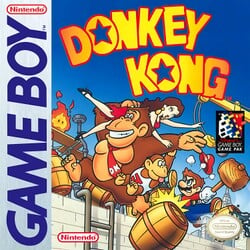 For alternate box art, see the game's gallery. | |||||||||
| Developer | Nintendo EAD, Pax Softnica | ||||||||
| Publisher | Nintendo | ||||||||
| Platform(s) | Game Boy, Virtual Console (Nintendo 3DS) | ||||||||
| Release date | Game Boy: Virtual Console (3DS): | ||||||||
| Genre | 2D Platform, Puzzle | ||||||||
| Rating(s) |
| ||||||||
| Mode(s) | Single-player | ||||||||
| Media | Game Boy:
Nintendo 3DS: | ||||||||
| Input | Game Boy:
Nintendo 3DS:
| ||||||||
Donkey Kong (alternatively Game Boy Donkey Kong, and Donkey Kong '94 in early development) is a Game Boy game released in 1994 by Nintendo. The game starts out with the premise of the original 1981 Donkey Kong arcade game. However, this game qualifies as both an extension and a standalone title; it features 97 additional stages beyond this original premise. It acts as a predecessor to Mario vs. Donkey Kong.
Donkey Kong is the first game in the Super Mario franchise with specialized support for colored graphics on the Super Game Boy peripheral for the Super Nintendo Entertainment System. Its Super Game Boy border resembles the arcade cabinet of the original Donkey Kong arcade game. The game has slight audio enhancements on the Super Game Boy: Pauline's distress cry sounds closer to a realistic cry for help (the Super NES's sound chip supports the inclusion of voice samples), and the credits theme was also enhanced.
Donkey Kong is one of the earlier re-releases on the Nintendo 3DS's Virtual Console, where it was released internationally in June 2011. It was released in South Korea on February 3, 2016.[2]
Story[edit]
The player takes the role of Mario. Donkey Kong kidnaps Mario's lady friend Pauline and carries her off to a construction site. In a repeat of the 1981 arcade classic, Mario follows him up to the highest point and makes Donkey Kong fall off the platforms by pulling out the rivets supporting them, causing Donkey Kong to fall a height of 100m, reuniting Mario and Pauline, just like the events that took place 13 years ago. However, Donkey Kong unexpectedly recovers, takes Pauline, and escapes with her into the Big-City. Mario pursues the two.
What follows is a chase throughout many different locations. Mario fights and defeats Donkey Kong at the end of each world, but Donkey Kong always stands up again and takes Pauline to the next location. Donkey Kong is aided by many of his friends as well as his son Donkey Kong Jr., who try to hinder Mario's progress. In the end, Donkey Kong escapes to the Tower beyond Rocky-Valley, where he and Mario have a confrontation on the top. After his defeat, Donkey Kong falls off the Tower, but he then takes many Super Mushrooms to augment his size to giant proportions. Mario faces the Giant Donkey Kong in an epic final battle. After Donkey Kong's final defeat, he falls from the Tower once again as Mario and Pauline are reunited once again. The ending scene shows Mario and Pauline in the Mushroom Kingdom as Pauline gives him a Super Mushroom to turn Mario into Super Mario. As Mario becomes super, Donkey Kong (now being back to normal) falls down on top of him. But because Mario now has super strength, he is able to lift up Donkey Kong. Having believed to be captured by both Mario and Pauline, Donkey Kong is left calling for help the same way Pauline did throughout the game. Donkey Kong Jr. jumps into the shot as a photo is taken and the credits roll. The ending photo of the game during the credits shows Mario, Pauline, Donkey Kong, and Donkey Kong Jr. posing in front of Rocky-Valley for a holiday photo, indicating that they have all made amends with each other.
Stages[edit]
| Image | Information | Levels |
|---|---|---|
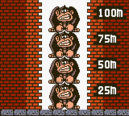
|
Construction Site - The construction site is the setting of the original Donkey Kong arcade game. In this world, Mario's goal is to get to Donkey Kong, who is standing on the top of the stages 25m, 50m, and 75m. Blocking Mario's path are enemies such as Fireballs, and platforms with gaps to jump across, elevators and Conveyor Belts. Donkey Kong also throws jacks at Mario. In the final stage of the world, 100m, Mario has to pull out all the rivets of Donkey Kong's construction to defeat him. | 4 |
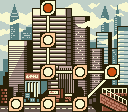
|
Big-City - Big-City is the first world of the game in which Mario has to unlock doors with keys. It is a basic world that serves as an introduction to the basic items and moves of the game, such as handstands, roads, and ladders. It also contains two boss fights with Donkey Kong. | 8 |
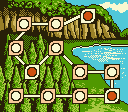
|
Forest - The Forest adds more gameplay elements to the game, such as vertical ropes to climb and water to swim in. Switches also make their first appearance - they can make roads appear and disappear. Snapjaws that climb on ropes can be taken out with fruit. These stages reference Donkey Kong Jr. | 12 |
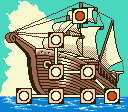
|
Ship - The stages on the Ship expand on the previously introduced game objects and add new puzzles to them. Mario now has to use Handstand Double Jumps, Wire Spins, and Walking Blocks (to get over spiked gaps) to progress. | 8 |
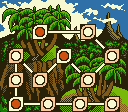
|
Jungle - The Jungle expands on all types of levels found in the Forest. The complexity of vertical ropes increases, and there are ally creatures like Monchees and Jumpers that help Mario to reach more areas. Enemies such as Dorakyū hinder Mario's progress while climbing ropes. | 12 |

|
Desert - The Desert is the first world to feature Super Hammers. They are used to break through walls. Most desert levels have more complex puzzle elements than the previous stages. In one stage, Mario has to take the Key up several stories to the door by only using ladders, roads and Jump Stands. | 12 |
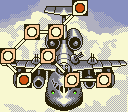
|
Airplane - The Airplane is the only world in the game not to feature generic enemies. Airplane levels often feature winds that blow Mario away sideways. He has to work across elevators, conveyor belts and has to avoid many cannons. The amount of moving platforms increases. Airplane stages also feature more than one locked door - the player has to remember the right one from which Pauline is seen screaming in the stage's intro. | 8 |
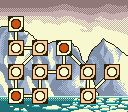
|
Iceberg - The Iceberg features many slippery surfaces. Mario has to jump across rocks that are swimming in the water and that slowly sink while he is standing on them. Icicles appear and can kill Mario as well as act as a platform for him to jump on once they hit the ground, or even before that. | 12 |
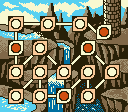
|
Rocky-Valley - Rocky-Valley features the most difficult puzzle stages of the game, but also requires the player to use Mario's moveset to the best of his abilities. There are many places which require strategic thinking and exact knowledge of the game's unusual physics. | 16 |
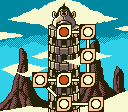
|
Tower - The Tower is the final stage of the game. In it, every single level is a boss fight with Donkey Kong or Donkey Kong Jr. Mario has to avoid many obstacles such as Poison Mushrooms and entire stages consisting of sand blocks. After Donkey Kong is defeated in stage 9-8, Mario has to fight him again in his giant form in stage 9-9. | 9 |
Gameplay[edit]
Level progression[edit]
The game starts out with four simple levels that Mario must scale in order to reach Pauline. These four levels are simplified versions of the original Donkey Kong arcade game. After reaching the top of the structure, Donkey Kong flees with Pauline into the city and beyond. The rest of the game's stages are divided between regular puzzle levels as well as more showdowns with Donkey Kong.
Each world has a varying amount of puzzle levels in which Mario needs to work against time to bring a key to a door to unlock it, thus advancing to the next level. The puzzles consist of building platforms and ladders and using them before they disappear, flipping switches, jumping on moving platforms, avoiding enemies and utilizing conveyor belts. Sometimes, Donkey Kong Jr. gets in Mario's way by flipping switches or throwing poisonous mushrooms at him to shrink him. All puzzles require the player to carefully time jumps and pay attention to the physics of the game - Donkey Kong thus is a cross between a platformer and a puzzle game.
As well as the puzzle levels, each world has at least two battles with Donkey Kong; one takes place part-way through the stage, and involves Mario reaching Pauline while avoiding the debris falling on him as Donkey Kong causes an impact. The second takes place at the end of each stage, and involves avoiding the barrels or other objects that Donkey Kong throws at Mario, picking them up and throwing them back at him. After beating a Donkey Kong boss level, there is a short cutscene of Mario chasing Donkey Kong while showing off how to do a special move in the game to the player. The player also gets one extra life for every 100 seconds of time left they had for the previous four levels, rounded up.
Each stage has a time limit in which it has to be beaten. It also keeps track of the high scores for each level. Whether the player made a new record is indicated on the Stage Clear screen after a Donkey Kong boss fight. The current high scores can also be viewed by pressing Start or Select.
In the final 'Tower' stage, each level consists of chasing Donkey Kong and Donkey Kong Jr. to the top of the tower, avoiding their attacks, eventually trapping Junior in a cage, and defeating a giant Donkey Kong in the final battle.
Mini-games[edit]
There are also three items left behind by Pauline in each puzzle level - a parasol, a hat and a bag. Picking all three up before finishing the level unlocks a bonus mini-game in which the player can pick up extra lives. In The Wheel of Fortune mini-game, all the player has to do is to press to stop the wheel to gain either 1, 2 or, in later worlds, 3 lives. It is not possible to lose in The Wheel of Fortune.
In the Slot-Machine mini-game, the player has to press three times to stop each reel of the slot machine. The icons appearing on the reels are Mario, Donkey Kong, Pauline's hat, a hammer, and a Fireball. Mario gains lives for getting one of the following combinations:
| Three Donkey Kongs | 5 Lives |
| Three Marios | 3 Lives |
| Two Marios | 2 Lives |
| One Mario | 1 Life |
| Three Hats | 2 Lives |
| Three Hammers | 1 Life |
| Three Fireballs | 1 Life |
| Donkey Kong, Mario, and Hat | Random |
Basic controls[edit]
Mario is controlled with the . The physics in Donkey Kong are vastly different to those found in the Super Mario series. The player can jump with the
. Mario's jump allows him to jump on enemies, but it does not go up considerably high. When falling farther than his jump height, Mario does a somersault which gives him a little bit of momentum. If he lands on a small platform, it can cause him to roll over the side and fall off. If he falls further, he gets stunned and is unable to move for several seconds upon hitting the ground, temporarily making him vulnerable. If he falls even farther, he lands on his head and dies upon impact with the ground.
Mario only has one hit point. While he is carrying any item, object or enemy, however, he cannot die. If he gets hit, he instead drops the item and becomes invulnerable for a short amount of time. This can save Mario for most kinds of impending deaths - he even survives spikes with it. If he falls too far, however, he drops the item in mid-air.
Mario's abilities[edit]
| Picture | Move | Execution | Effect |
|---|---|---|---|

|
Crouching | Holding Down on the |
In the crouching position, Mario can avoid enemy projectiles more easily. He can also get through smaller passages while crouching and being on a conveyor belt or if Mario is pushed along by some enemies. |

|
Handstand | Holding Down on the |
The handstand is an essential move in the game. While doing a handstand, Mario is protected from most items that drop onto him from above. Handstands also serve as a preparation for several other moves that Mario can only execute from the handstand position. While doing a handstand, Mario can still move to the right and to the left, but it is considerably slower than walking. |

|
Handstand Jump | Pressing |
Handstand Jumps allow Mario to reach platforms above him. If the Handstand Jump is timed right after Mario goes into the handstand position, a Handstand Double Jump is performed which allows Mario to reach even higher. |

|
Backflip | Pressing |
Backflips allow Mario to quickly reach higher platforms. They reach higher than Handstand Jumps, but come at the disadvantage of having to be in movement to execute them, so they cannot be done on small platforms easily. |

|
Wire Spin | Pressing up on the |
Mario can hang onto horizontal ropes if he jumps at them. While hanging on the rope, he can perform a Wire Spin. A subsequent Wire Jump makes it possible for him to reach areas that are very high or very far away. The direction that Mario jumps to after the spin depends on the orientation of the rope. Sometimes, it is just upwards, sometimes it is sideways as well. |

|
Picking up objects | Pressing |
Similar to Super Mario Bros. 2, Mario can pick up objects like the key while standing on them. This also works for several enemies in the game. |

|
Throwing objects | Pressing |
Thrown objects can hit enemies and take them out. Some enemies are invulnerable to thrown objects. Mario also has to throw items like the Key upwards (by pressing up on |
Enemies[edit]
Donkey Kong features the enemies from the original arcade game Donkey Kong and many individual enemies of its own that are only found in this game. It does not feature any enemies from the mainstream Super Mario games, except for Spark, who appears in Super Mario Bros. 2. Many enemies in the game have a different appearance, but the exact same behavior. The appearance usually depends on the current world.
| Enemy | Name | Debut | Abilities |
|---|---|---|---|
| Fireball | Construction Site, 25m | Fireballs chase Mario and can appear out of oil drums that catch fire. If Mario touches one, he burns up. It can be defeated with the hammer. | |
| Fire | Construction Site, 100m | Fireballs that are slightly larger than usual and spawn from the sides of the screen. If Mario touches one, he burns up. It can be defeated with the hammer. | |
| Oil | Big-City, Stage 1-1 | Oil only consists of an aura of fire with the text "oil" written on it. It floats up and down in place without trying to attack Mario, but touching it is deadly. It can be defeated with the hammer. | |
| Bowbow | Big-City, Stage 1-1 | Bowbows just lumber horizontally from one side of a platform to another. Mario dies if he gets in contact with a Bowbow from the front or back, but he can easily hop on its head, pick it up and hurl it away. If Mario approaches Bowbows with the hammer, they start to run away in panic. | |
| Rappy | Big-City, Stage 1-2 | These enemies circle completely around midair platforms, including walking on their bottom side. In other stages, they also walk around the entire border of the level, even over spikes. They cannot hurt Mario, but they can push him off the platform if he is in their way. They can also be stood on, but not picked up. | |
| Dotty | Forest, Stage 2-1 | ||
| Arumajiron | Desert, Stage 5-7 | ||
| Purupuru | Iceberg, Stage 7-3 | ||
| Wire Trap | Big-City, Stage 1-3 | Sparks which move along horizontal ropes and electrocute Mario if he touches them. They may also appear and disappear from the rope in certain time intervals. They can also not be harmed in any way. | |
| Dust Man | Big-City, Stage 1-3 | Dust Men look like ordinary Trash Cans at first glance, but grow feet and eyes once Mario gets too close. They then wander around aimlessly and can defeat Mario if they knock into him. Mario can safely stand on top of them, but they cannot be lifted like normal Trash Cans. | |
| Faiachū | Big-City, Stage 1-5 | Fireballs with feet that circle around the area, and they also walk up walls and on ceilings. They burn Mario if he comes into contact with them. Faiachū also cannot be taken out by Trash Cans. In the Iceberg world, Faiachū melt Ice Blocks as soon as they walk over them, clearing the path for Mario to reach other areas of the level. | |
| Sniper | Forest, Stage 2-1 | These enemies circle completely around midair platforms, including walk on their bottom side. In other stages, they also walk around the entire border of the level, even over spikes. They kill Mario if he touches them. | |
| Sukōpī | Desert, Stage 5-11 | ||
| Chikuchiku | Rocky-Valley, Stage 8-2 | ||
| Gyātoru | Tower, Stage 9-3 | ||
| Dōryī | Forest, Stage 2-3 | Dōryī shoot out seeds in regular intervals. The seeds fly horizontally across the screen and kill Mario if he touches them. However, Mario can touch the plants themselves and stand on them fine. | |
| Snapjaw | Forest, Stage 2-4 | Snapjaws can climb ropes up and down. They kill Mario if he touches them, and they can only be defeated by dropping objects like fruit onto them. They are thrown by Donkey Kong Jr. | |
| Bukubuku | Forest, Stage 2-5 | Bukubuku swim around horizontally, but charge at Mario if they get into eye contact with him. Touching a fish kills Mario. | |
| Thwomp Platform | Forest, Stage 2-8 | If Mario approaches a Thwomp Platform, they drop down and try to crush him. Mario can jump on them and use them as elevators. Thwomp Platforms can also crush Mario by pushing him against the ceiling. | |
| Kaibādo | Jungle, Stage 4-1 | These enemies fly out of their nests and cross the screen horizontally. At times, when they fly over Mario, they stop and attempt to drop an egg on him. Touching the eggs or the enemies themselves is deadly. | |
| Hawks | Forest, Stage 2-9 | ||
| Bird | Tower, Stage 9-4 | ||
| Sairesu | Forest, Stage 2-10 | Sairesu are usually found sleeping on the floor. If they hear Mario approaching, they wake up and quickly charge at him. If Mario touches them, he gets killed. If he escapes them, Sairesu fall asleep again. Sairesu run faster than any other enemies in the game. | |
| Walking Block | Ship, Stage 3-1 | Walking Blocks slowly walk horizontally, including across spikes. Mario can jump onto them to cross larger areas of spikes. Walking Blocks do not hurt Mario in any way. | |
| Sir Shovalot | Ship, Stage 3-2 | Sir Shovalots hold their shield up and charge at Mario as soon as they see him. They do not hurt Mario themselves, but they push him away. They can push Mario off the platform he is currently standing on, but they can also push him against a wall, squishing him in the process. | |
| Kānyī | Ship, Stage 3-2 | Kānyī walk around slowly, and sometimes stop and hide in their shell. Mario can stand on them fine, but are defeated if he walks into them from the side. Kānyī also hurt Mario by reaching out to him with their extendable claws. | |
| Aqua Man | Ship, Stage 3-3 | These enemies only walk around horizontally. If Mario runs into them, he loses a life. He can stand on them, and they can also be picked up and thrown at other enemies. They can also be defeated with the hammer. | |
| Miira | Desert, Stage 5-2 | ||
| Penpen | Iceberg, Stage 7-2 | ||
| Golem | Tower, Stage 9-1 | ||
| Robo NO.1 | Tower, Stage 9-6 | ||
| Gessori | Ship, Stage 3-7 | Gessori move around in the water horizontally. They kill Mario if he touches them. | |
| Dorakyū | Jungle, Stage 4-5 | Dorakyū fly horizontally across the screen. When they hit Mario, they hang onto him and appear to suck a little bit of blood out of him. Mario's face turns white (in the colored Super Game Boy version) and he falls off the rope he is currently climbing. After falling to the ground, Mario gets up again. Mario can also get killed by Dorakyū if he falls too far after dropping from the rope. | |
| Skeleton | Desert, Stage 5-2 | Skeleton foes move on the ground and throw bones on occasion. These bones, as well as the enemies themselves, are harmful for Mario, but they can be destroyed with a Hammer. | |
| Furafurawā | Desert, Stage 5-2 | In the Desert, Furafurawā hide in the ground. If Mario approaches them, they pop out of the ground and move left and right slowly until he walks way. As soon as Mario is out of reach, Furafurawā hide again. Touching a Furafurawā kills Mario. They can be defeated with the Hammer, but respawn from the ground instantly.
In Rocky-Valley, Furafurawā have a totally different behavior. They walk around slowly from the left to the right, and sometime shoot out four small seeds that behave like those of a Volcano Lotus. The seeds can be taken out with a Hammer. These Furafurawā do not respawn. | |
| Tsutan'ōmen | Desert, Stage 5-12 | These enemies are thrown by Donkey Kong. When they hit the ground, they begin to walk around and kill Mario if he runs into one. Mario has to jump on them, pick them up and throw them at Donkey Kong to beat him. | |
| Rokkun | Rocky-Valley, Stage 8-16 | ||
| Spark | Airplane, Stage 6-4 | An electrified foe that completely circles around a platform. | |
| Ottō | Iceberg, Stage 7-2 | Ottō does not try to hurt Mario, but it jumps onto him and prevents him from walking or pulling switches for a certain amount of time. | |
| Tododesu | Iceberg, Stage 7-2 | Tododesu patrol across the screen protecting the key. If a Tododesu gets into eye contact with Mario, it charges at him with its fangs. Mario can stand on it, but he cannot pick it up like other enemies in the game. |
Allies[edit]
| Ally | Name | Debut | Abilities |
|---|---|---|---|
| Monchee | Jungle, Stage 4-3 | Monchees have a long tail that Mario can use like a regular vertical rope. He can climb on it use it to cross gaps. Touching a Monchee does not hurt him. | |
| Jumper | Jungle, Stage 4-10 | When Mario is standing on a Jumper frog, it jumps up high in the air, allowing him to reach higher platforms while carrying the key. Jumpers can also be taken out if objects such as the key are thrown at them. |
Items[edit]
| Item | Name | Effect |
|---|---|---|
| Hammer | Hammers can defeat all enemies in the game. As soon as Mario grabs a hammer, he starts swinging the hammer back and forth repeatedly, and strikes anything in his path. While holding the hammer, Mario cannot jump, but he can throw the hammer upwards and then quickly climb up to a higher platform. If he catches the hammer up there in time, he can continue to use it. After a certain time, the hammer disappears and reappears in its original spot. | |
| Parasol, Hat & Bag | If Mario collects all three of these items within the same level, he gets to play a bonus mini-game after it is finished. | |
| 1 UP Heart | Gives Mario an extra life when collected. | |
| Key | Mario has to take the key to the locked door. It can be picked up and thrown. It can also take out several enemies if it is thrown. If Mario loses it, it disappears after a few seconds and reappear in its original spot. | |
| Trash Can | Mario can stand on Trash Cans to reach higher areas, but he can also pick them up and throw them at enemies like Bowbows to defeat them, although other enemies like the Faiachū cannot be defeated by Trash Cans. Once it hits an enemy, it falls through the ground and cannot be reused. | |
| Road | Mario can place the road in any free point of the level for a certain amount of time. The road acts as an additional platform that can help him to get over gaps or to higher areas. | |
| Ladder | Mario can place this ladder in any free point of the level. It disappears after a certain amount of time. | |
| Jump Stand | Mario can place this spring in any free point of the level. It disappears after a certain amount of time. | |
| Super Hammer | The Super Hammer has the same powers as the regular hammer, but can also destroy brick walls and grounds. They also respawn to their original positions when used up. |
Objects and obstacles[edit]
- Barrel - Donkey Kong throws barrels at Mario. He has to avoid them, and can also pick them up if they hit the ground. Barrels can be stopped falling by kicking against them in handstand position.
- Cannon - Indestructible obstacles that come in several configurations. Most fire bullets horizontally, and some charge up energy balls in other directions. Touching either projectile will cost Mario a life.
- Cement tub - As in the original arcade game, they kill Mario if he runs into one.
- Conveyor Belt - Conveyor belts move Mario and any other object such as the key into a certain direction. The direction of conveyor belts can be manipulated by Donkey Kong or via switches.
- Elevators - They allow Mario to get up or down. As falling too far kills Mario in the game, using them to get downwards is required on several occasions. Switches can change their direction.
- Ice Blocks - Small platforms in some Iceberg stages that melt when Faiachū walk over them.
- Icicles - Icy obstacles that fall from the ceiling in some Iceberg stages and can be temporarily used as platforms on the floor.
- Jack - They are thrown by Donkey Kong in some stages and kill Mario if he gets hit by one.
- Jump Stand - They are stationary and give Mario a jump boost when he lands on one.
- Ladder - Ladders are used to climb upwards. Several ladders in the game open and close at certain time intervals or when Donkey Kong hits the ground with his fist. While they are closed, Mario cannot go upwards on them.
- Switch - Switches have many different effects in the game. They can make roads and ladders appear disappear as well as open doors, and change the direction of conveyor belts and elevators.
- Locked Door - Mario progresses to the next level if he takes the key to it. In several levels, multiple locked doors appear, but only the one from which Pauline is seen screaming actually opens. In other levels, the locked door is hidden in the wall and the player has to remember its position.
- Oil drum - As in the original arcade game, they spawn Fireballs.
- Rope (horizontal) - Strings held together at both ends. Most are horizontal, but some are diagonal. Mario can spin on these and aim a jump to attain higher ground. Wire Traps travel on some of these as well.
- Rope (vertical) - Vertical ropes return from Donkey Kong Jr. Mario can climb up and down on them, and he climbs faster if he can hold onto a rope with each of his hands.
- Moving platform - They move around in fixed patterns at different speeds. Their direction can be changed with a switch.
- Sand blocks - Blocks that dissolve when Mario walks over them.
References to other games[edit]
- Donkey Kong: The original Donkey Kong's plot is remade and extended in this game and even begins with shortened versions of all four stages; it also includes both the hammer and Pauline's dropped items. Additionally, the original version of 25m is remade as Stage 9-5.
- Donkey Kong Jr.: The character, as well as many enemies and gameplay elements from the game itself, are featured in the game.
- Super Mario Bros.: Donkey Kong uses Super Mushrooms to grow giant for the final battle. Also, the ending features a Warp Pipe and three ? Blocks (and Mario changing into Super Mario), suggesting that at least Worlds 8 and 9 are located in the Mushroom Kingdom. Additionally, the 1-Up Mushroom sound effect is included in the game.
- Super Mario Bros.: The Lost Levels: Poison Mushrooms return from this game.
- Super Mario Bros. 2: The ability to pick up and throw items, as well as using keys to open doors, originated from this game.
- Super Mario World: The warning tone heard when star power or a switch's effects are about to end is used for the platform timer.
References in later media[edit]
- Donkey Kong: This Nelsonic Game Watch is an adaptation of Stage 1-7.
- Donkey Kong Jungle Action Special: The comic "A Blast From The Past" is a loose adaptation of the game.
- Donkey Kong Land: Big Ape City is, or at least is a reference to, Big-City.
- Super Mario 64: Many of Mario's moves return in this game.
- Wario Land II: The theme for the Matching and Number-matching Games is borrowed from the game.
- Mario vs. Donkey Kong: This game was originally planned to be a Game Boy Advance remake of the game, but ended up being a semi-sequel. As such, it uses all gameplay elements from the game, although it has a very different story.
- Super Mario 64 DS: The slot machine minigame reappears.
- Mario vs. Donkey Kong 2: March of the Minis, Mario vs. Donkey Kong: Minis March Again!, Mario vs. Donkey Kong: Mini-Land Mayhem!, Mario vs. Donkey Kong: Tipping Stars: The characters can throw their hammers upward to take it back at an upper level, as in Donkey Kong for the Game Boy. Pauline's design is reused.
- Super Mario Run: The landing roll and backflip return.
- The Super Mario Bros. Movie: Donkey Kong's redesign for the film most closely resembles his appearance in Donkey Kong for the Game Boy, which was the last appearance of the classic look for Donkey Kong (which incidentally also features a necktie for the titular character) before the redesign that occurred with the original Donkey Kong Country.
Pre-release and unused content[edit]
Early footage of the game was featured in a promotional tape sent to Nintendo retailers in late 1993 and early 1994.[3] Differences include the sprites being closer to the original Donkey Kong, the level timer starting at 999 instead of 100, and various different enemies and designs. Footage of a later build featuring a similar Donkey Kong with a tie and the final Pauline is included in a Nintendo Power Previews LaserDisc used in store kiosks.[4] Nintendo Power magazine shows additional differences, such as a world map having changes such as an early icon for Donkey Kong. At some point, a "Giant Squirrel", pictured below, was a boss that Mario had to fight. A noticeable difference, besides that Donkey Kong and Donkey Kong Jr. are normally the only bosses fought, is that the stage has a very basic layout that does not fit with the more puzzle-like layout of the other stages.
Staff[edit]
- Main article: List of Donkey Kong (Game Boy) staff
Executive producer[edit]
Producer[edit]
Directors[edit]
- Masayuki Kameyama
- Takao Shimizu
Main programmers[edit]
- Yoshiaki Hoshino
- Masayuki Hirashima
Co-programmer[edit]
- Motoo Yasuma
Critical reception[edit]
The game has been received positively overall. Nintendojo named it one of the best Game Boy games ever made and rated it 9/10. They noted the game's innovate gameplay and its "seamless fusion" of the original arcade game with puzzle elements.[5] The German magazine Video Games noted that the game "belongs into every Game Boy collection" for its "love of detail and elaborate platform levels". They praised the game for providing new surprises in each new world, which keep the player at a high degree of motivation, and also for its battery storage. They gave the game 90%.[6] IGN.com said that the game took the "classic design to new heights with fresh action and puzzle elements that faithfully retained the Donkey Kong arcade game's look and feel". They said it was a "classic and amazingly fun" Game Boy game.[7]
| Reviews | |||
|---|---|---|---|
| Release | Reviewer, Publication | Score | Comment |
| Nintendo 3DS | Marcel van Duyn, Nintendo Life | 9/10 | "First impressions can be misleading. With 101 stages, Donkey Kong for the Game Boy is far more than just a simple sequel to the arcade game. It adds a metric ton of new features, while still managing to keep the ‘arcadey’ feel of the original. The graphics and music are outstanding for a 1994 Game Boy title and the game itself is just incredibly fun to play, even if you do receive an over-abundance of extra lives. It may not be part of the ‘main’ Mario series, but this is easily one of the best Mario games ever made. At a price of $4, or £3.60 in the UK, it should be an essential download for everybody with a 3DS." |
| Nintendo 3DS | Adam Riley, Cubed3 | 8/10 | "Nintendo has a knack of taking old classics and revamping them for the new generation. Now, whilst other companies do exactly the same, they do not have the same consistently AAA results that Nintendo manages to achieve time and time again. With Donkey Kong, the old crusty arcade version was dragged from the archives, brushed down then given a brand new lick of paint that left it so shiny that it still dazzles even today on the Virtual Console" |
| Nintendo 3DS | Mike Rose, Pocket Gamer | 4/5 | "If you haven't tried Donkey Kong before, make sure you pick it up from the eShop. While it has undoubtedly aged, it still contains the elusive Nintendo magic." |
| Aggregators | |||
| Compiler | Platform / Score | ||
| GameRankings | 84.83% | ||
Nintendo 3DS description[edit]
Donkey Kong has once again kidnapped Pauline!
Challenged by many perils, Mario™ must reach his archrival in order to save our damsel in distress. As Mario makes his way through a series of platforms while jumping and dodging obstacles, he will also need to gather disappearing keys to unlock doors to hidden rooms. Donkey Kong will stop at nothing to confuse and trap our hero. Help guide Mario as he journies to the top! With 10 stages and 100 tricky levels to solve, it is a long trek to the final confrontation!
Gallery[edit]
- For this subject's image gallery, see Gallery:Donkey Kong (Game Boy).
Media[edit]
- For a complete list of media for this subject, see List of Donkey Kong (Game Boy) media.
Music[edit]
| File info 0:30 |
| File info 0:30 |
Names in other languages[edit]
| Language | Name | Meaning |
|---|---|---|
| Japanese | ドンキーコング Donkī Kongu ゲームボーイ ドンキーコング[8] Gēmu Bōi Donkī Kongu |
Donkey Kong Game Boy Donkey Kong |
Trivia[edit]
- This is the first game, and so far the only one, to have Donkey Kong and son working together in order to get Pauline and defeat Mario.
- This is also the only game to have Donkey Kong Jr. as an antagonist.
- The Nintendo eShop description for this game erroneously states its release date was 6/1981, one month prior to the release date of the original Donkey Kong arcade game.
- This is the first game in which Donkey Kong is wearing a tie.
- Donkey Kong in this game is the most recurring boss in a single game of the extended Super Mario franchise.
- This is the last major appearance of the original Donkey Kong; as of the next game, he is a separate character called Cranky Kong.
- The design used for Donkey Kong in this game is derived from a sketch drawn for the current Donkey Kong by Shigeru Miyamoto, whereas the sketch that actually established the character's current design was created by Rare.
References[edit]
- ^ Super Smash Bros. Brawl Chronicle
- ^ South Korean Nintendo 3DS Virtual Console page
- ^ Toad.T (January 30, 2014). Service Center Update February 1994 (Featuring Super Metroid and Sound Fantasy Beta Footage!). YouTube. Retrieved April 27, 2014. (Donkey Kong-relevant part starts at 7m48s)
- ^ Hard4Games (August 15, 2020). Nintendo LaserDisc! | Nintendo Power Previews LaserDisc V7 Preservation. YouTube. Retrieved August 25, 2020. (Donkey Kong-relevant part starts at 11m8s)
- ^ Donkey Kong Review at Nintendojo
- ^ Donkey Kong review by Video Games, scan from kultpower.de
- ^ Mario vs. Donkey Kong review on IGN
- ^ (1994). 『Game Boy Donkey Kong 取扱説明書』. Nintendo Co., Ltd. (Japanese). Page 0.
External links[edit]
| Game Boy games | |
|---|---|
| Super Mario franchise | Alleyway (1989) • Baseball (1989) • Super Mario Land (1989) • Golf (1989) • Dr. Mario (1990) • Super Mario Land 2: 6 Golden Coins (1992) • Donkey Kong (1994) • Mario's Picross (1995) • Picross 2 (1996) |
| Donkey Kong franchise | Donkey Kong (1994) • Donkey Kong Land (1995) • Donkey Kong Land 2 (1996) • Donkey Kong Land III (1997) |
| Yoshi franchise | Yoshi (1991) • Yoshi's Cookie (1992) • Tetris Attack (1996) |
| Wario franchise | Wario Land: Super Mario Land 3 (1994) • Wario Blast: Featuring Bomberman! (1994) • Wario Land II (1998) |
| Miscellaneous | Tetris (1989) • The Legend of Zelda: Link's Awakening (1993) • Game & Watch Gallery (1997) • Game & Watch Gallery 2 (1997) |
